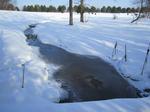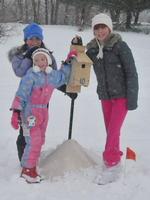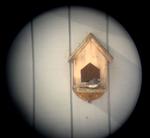Posted on Tuesday, January 3, 2012
Snow has a mixed reputation. Some people like it, others tolerate it and still others despise it. In a Facebook post, one person wrote this about snow: "I like photographing snow and that's about it. I've had the last 20 winters to get the effect, I'm getting tired of it." Another person, in counter response, stated emphatically: "Me me!!!! I love snow." This winter may favor the first person, but at the Field Station we are with the second one.
Snow happens when atmospheric conditions are just right. High up, water vapor condenses onto particles of dust, called aggregate nuclei. A massive collection of these water droplets suspended in the air makes a cloud. Snow-forming clouds are mostly supercooled liquid droplets (water cooled below the freezing point and still a liquid). As the cloud gets even colder (14 to 15 degrees F), droplets start to freeze. But not all freeze at once. The ice grows as water vapor condenses onto surfaces, forming six-sided snowflakes in the process. Falling snowflakes may melt before they reach the earth's surface to form rain if the air temperature exceeds the ordinary freezing point of water. Snow requires a combination of temperature, air pressure and humidity.
Snow is a wonder of nature that our area relies on to balance the cycles and energetics of nature. Like it or not, without snow, we would be in a totally different plant and animal community than we are now. Snow ecology is the science of the relationships between organisms and their environment that include falling snow and snow-cover. The Field Station would be a good place to study the events and the effects of snow.
In the 1950s, a Norwegian botanist, Olav Gjaerevoll, analyzed the way in which plant community structures were shaped by snow. That study, though from Norway, is still valid. Some plants are highly dependent on snow-cover to thrive, reproduce sexually and asexually. As every biologist knows, plant communities determine the animal communities of any region.
The short-tailed shrew (not a mole, although related to it) lives in shallow burrows and nests but must be up and about every day of the year, snow or no snow. Shrews do not hibernate; in fact, they fatten up in winter. A book, Mammal Species of the World, states that shrews must consume up to three times their weight in food each day, including winter. Walk the Frey Nature Trail of the Field Station after snowfall and you can spot the zigzag or curly patterns raised under the snow. Those are paths of shrews as they scurry just below the soil-snow interface munching on dormant insects and even other small mammals.
Cottontail rabbits are also active year round. Their tracks are easy to identify in the snow. But can one tell which direction the cottontail is moving? This is an excellent snow-related question for children who come to the Field Station in winter.
Birds are creatures that follow a simple rule: love it or leave it. Migratory birds leave it, for a while. We think of most birds as migrating south to warm climes but the dark-eyed junco is a bird that migrates south in winter to our region from across Canada and Alaska. It is a true snow bird.
Within the past decade, snow manipulation experiments by ecologists have explored more complicated effects of snow depth and snow-cover duration on plant and animal communities and ecosystem processes. Recently, computer models of snow-cover have been applied to ecological problems and climate change.
Snow plays several roles in temperature regulation of the environment. The amount of light that is reflected by a material is called the albedo. Very dark materials have an albedo of 0 (no reflection at all) and very white materials have an albedo that approaches 1.0 (total reflection, an impossibility). The albedo of fresh snow on a sunny day is 0.8 or higher, melting snow 0.7 and lake ice (as on Brittain Lake) about 0.5. These values are important for scientists to calculate the extent of our "heat sink" that removes energy from the atmosphere in the form of heat. This means that the presence of snow-cover inhibits soil warming until the snow melts, preventing biological activity that requires temperatures above freezing. Snow is an efficient insulator; it keeps the surface temperatures near freezing but not much below that when there is a sizeable snow-cover. At the Travis Weather Station we have temperature probes in the air, on the soil surface and at a range of depths. When there is a snow cover, the surface soil temperatures tend to run 7 to 10 degrees F warmer than air temperatures.
Our period of snow-cover is about eight to 10 weeks each season. This year, that period could be shorter. We have had only two times in December when there was measurable snowfall.
The annual average temperature for 2011 was 50.4 degrees F; in 2010 it was 49.4 and in 2006 48.92. Is this evidence of climate change? Not necessarily. Our location in the mid-latitudes signals an expectation that there will be great variation of annual average temperature within the range of "normal," that for us is about 50 degrees F. Our data from the Weather Station for the past 30 years show that we are very close to this average. But imagine Western Pennsylvania if those who hate snow were given their wish of, perhaps, only one week or less of snow-cover each and every season, year after year. In that scenario there would be a significant increase in the annual average temperature. Plants communities would change and so would the animals. Let it snow!
Clarence Harms, Director
Field Station
(724) 946-6001
harmsc@westminster.edu



